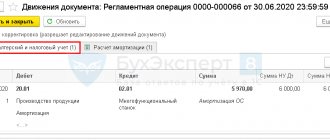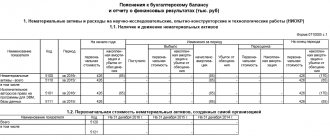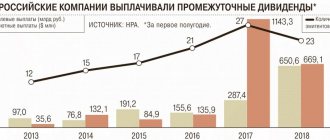From 2021, the procedure for accounting for intangible assets has changed. This is due to the start of application from January 1, 2021 of the Federal Standard “Intangible Assets”. In order to ensure uniformity in the accounting of intangible assets, changes were made to Instructions Nos. 157n, 162n, 174n and 183n, as well as Procedure No. 209n *(1). In addition, the Ministry of Finance of Russia, by system letter dated November 30, 2020 No. 02-07-07/104384, updated the Methodological Recommendations for the application of the Intangible Assets Standard.
Based on the provisions of the mentioned regulatory legal acts and the system letter, we will consider in the article how to take into account intangible assets from 2021.
Reasons for writing off intangible assets
According to clause 34 of the Regulations, the cost of a retiring asset or object that is no longer capable of generating economic benefits is subject to write-off in accounting. At the same time, the amount accumulated in the account is written off. 05 depreciation (when using this account). Possible reasons for disposal of intangible assets are:
- Completion of the established period of validity of exclusive rights to the asset.
- Transfer on the basis of alienation of the right to an object.
- Transfer of rights to an asset to other third parties, including due to collection or succession.
- The onset of obsolescence, leading to the impossibility of further use of the asset.
- The object's contribution to the authorized capital or mutual fund.
- Transfer of an asset under a gift/exchange agreement.
- Introducing intangible assets as a contribution to joint activities.
- Detection of the fact of shortage of an asset during inventory.
- Other circumstances.
Possible reasons for writing off intangible assets
As the most common reasons for writing off intangible assets, the main document dedicated to these assets (PBU 14/2007, approved by order of the Ministry of Finance of Russia dated December 27, 2007 No. 153n), names their disposal (clause 34) due to:
- expiration of the validity period of the right to the asset;
- transfer of rights to it;
- obsolescence of intangible assets;
- his contribution to the management company or mutual fund;
- transfers by exchange or gift;
- contribution to property united for joint activities;
- shortages identified during inventory.
For whatever reason, the disposal of intangible assets occurs, as of the date of this event the following must be written off from accounting (clause 34 of PBU 14/2007):
- book value of the asset;
- the amount of depreciation accrued on an asset over its useful life.
The following circumstances deserve special attention here:
- For an asset that implies mandatory registration of the right to use, recognition of disposal will occur on the date of registration of this right for the person to whom such an asset is transferred (clause 36 of PBU 14//2007, subparagraph “d”, clause 12 of PBU 9/99, approved by order of the Ministry of Finance of Russia dated 05/06/1999 No. 32n, clause 19 PBU 10/99, approved by order of the Ministry of Finance of Russia dated 05/06/1999 No. 33n).
- The difference between the values related to an intangible asset and subject to write-off upon its disposal (accounting value minus depreciation) constitutes its residual value, which may be revalued during the accounting period (clauses 16–19 of PBU 14/2007). When a revalued asset is disposed of, the amount of its revaluation, which is included in additional capital, should be removed from accounting at the same time (clause 21 of PBU 14/2007).
Read more about revaluation in the material “Revaluation of non-current assets on the balance sheet is...”.
- Depreciation for the month of asset disposal must be accrued in an amount corresponding to a full month (clause 32 of PBU 14/2007).
- An acceptance and transfer certificate signed by the head of the organization or a person authorized by him for this purpose, upon sale, exchange, donation, contribution to a management company (mutual fund) or joint activity.
- A write-off act, drawn up and signed by a commission appointed by the head of the legal entity, upon disposal at the end of the validity period, due to obsolescence or as a result of a shortage. In the latter case, the act must be preceded by an inventory list and a matching sheet, for which it is possible to use forms INV-1a and INV-18, approved by Resolution of the State Statistics Committee of the Russian Federation dated August 18, 1998 No. 88.
Documents for writing off intangible assets
The procedure for writing off intangible assets after the expiration of their useful life (USP) is accompanied by the preparation of primary documentation in accordance with Art. 9 of Law No. 402-FZ dated December 6, 2011. The forms can be approved by the head of the enterprise with the entry of all mandatory details, including the reason for disposal.
List of documents for write-off of an asset in connection with the end of the established SPI:
- The act and order for writing off intangible assets - the forms are signed by the head of the company; it is required to indicate the basis for writing off the object. In the case of a special commission, the act is signed by all participants, and the composition is pre-approved by the director of the enterprise.
- Intangible asset registration card - on the basis of the drawn up act, the corresponding entries on the write-off of the object are made in the registration card. Depreciation ceases from the month following the disposal period.
In which accounts should intangible assets be recorded?
The accounting account for an intangible asset depends on the right under which it was obtained.
| Right | Account | Example |
| Exclusive right | 0 102 XN 000 “Scientific research (research development)” 0 102 XR 000 “Experimental design and technological development” 0 102 XI 000 “Software and databases” 0 102 XD 000 “Other intellectual property” | Exclusive right to software - account 0 102 ХI 000; Exclusive right to a selection achievement - account 0 102 ХN 000; Exclusive right to a trademark - account 0 102 ХD 000; Exclusive right to an invention - account 0 102 ХN 000 |
| Non-exclusive right | 0 111 6N 000 “Rights to use scientific research (research developments)” 0 111 6R 000 “Rights to use experimental design and technological developments” 0 111 6I 000 “Rights to use software and databases” 0 111 6D 000 “Rights to use other objects of intellectual property" | Non-exclusive right to antivirus - account 0 111 6I 000; Non-exclusive right to a utility model - account 0 111 6N 000; Non-exclusive right to an electronic archive - account 0 111 6I 000; Non-exclusive right to a literary work - account 0 111 6D 000. |
Objects of intangible assets are grouped according to clause 37 of Instruction No. 157n. That is, objects received under exclusive right are accounted for in the corresponding account 102 00, where X can take the value 2 “Especially valuable movable property of the institution”, 3 “Other movable property of the institution” or 9 “Property in concession”.
More on the topic: How to determine the useful life without OKOF?
For example, on account 102 91 “Software and databases in concession” information about programs for electronic computers, databases, information systems and (or) sites on the Internet or other information and telecommunication networks that are the objects of concession agreements is subject to reflection. which includes such computer programs and (or) databases, or about the totality of these objects, as well as about operations that change them.
The grouping by type of property, designated by the letters N, R, I or D, corresponds to the subsections of the classification established by OKOF *(3) (clause 67 of Instruction No. 157n, letter of the Ministry of Finance of Russia dated September 17, 2020 No. 02-07-10/81813). Namely, OKOF provides for the following groups of intellectual property objects (OKOF code 700):
- scientific research and development (OKOF code 710);
- software and databases (OKOF code 730);
- other objects of intellectual property (OKOF code 790).
For example, multimedia applications are named in the “Software and Databases” group - OKOF code 732.00.10.08. Consequently, the exclusive right to this object, related to other movable property, is taken into account in account 102 3I. And if an institution has a non-exclusive right to multimedia applications, then it will be reflected in account 111 6I.
Write-off of intangible assets - postings
The financial result from the disposal of intangible assets is generated by the organization's accountant on the account. 91 (clause 35 of the Regulations) as part of other income/expenses. All standard transactions should be reflected in the period when the income or expense was actually generated. In this case, the following transactions are made:
- D 05 K 04 – intangible assets are written off through accrued depreciation.
- D 91.2 K 05 – the residual value of intangible assets is written off as other expenses if the account. 05 was used.
- D 91.2 K 04 – the residual value of intangible assets is written off as other expenses if the account was not used. 05.
If the enterprise additionally incurred costs in connection with the disposal of the object, the following entry is made:
- D 91.2 K 60, 76, 10, 69, etc.
Accounting entries for write-offs
The financial result from the disposal of intangible assets is formed through the reflection of data related to it in other income and expenses (clause 35 of PBU 14/2007). This reflection is preceded by the formation of the residual value of the disposal asset:
Dt 05 Kt 04.
This cost is written off as expenses by posting:
Dt 91 Kt 04.
By a similar entry, expenses associated with the disposal of intangible assets will be debited to account 91 from the credit of accounts for accounting for settlements with counterparties:
Dt 91 Kt 60 (76).
If the identified shortage is the fault of a certain employee, then the following may occur:
Dt 73 Kt 04.
The resulting income from the transfer (which may occur during a sale or exchange) will be reflected by posting:
Dt 62 Kt 91.
The amount of accrued income will include VAT, the amount of which will be highlighted by posting:
Dt 91 Kt 68.
The same VAT entry will arise when donating an asset (based on the market value of this asset), despite the absence of an income accrual entry.
In relation to the revalued object, for which at the time of disposal the revaluation amount was present in the accounting records, the following entry will be made:
Dt 83 Kt 91.
Acceptance of intangible assets for accounting
After completing the purchase of an intangible asset, it should be registered for further operations on it. To accept intangible assets for accounting, use the document of the same name “Acceptance for accounting of intangible assets.” To enter it, go to the “OS and intangible assets” menu, then “Accepting intangible assets for accounting”, then the “Create” button.
In the header of the document, fill in the only detail – “Organization”.
At the bottom of the document, we select an intangible asset and how depreciation will be reflected. The choice is made from the directory “Methods of reflecting expenses”. I made an entry in it with the name “Intangible assets” and indicated that the costs would be charged to account 26:
This is what the “Non-current asset” tab looks like after filling it out:
Go to the “Accounting” tab.
We indicate the accounting account – 04.01. The initial cost in 1C 8.3 can be entered manually, or you can use the “Calculate” button. We will indicate the method of receipt as “Purchase for a fee.”
After checking the “Calculate depreciation” checkbox, a section with depreciation parameters becomes available to us.
Let us indicate that the useful life is 120 months, the method of calculating depreciation is linear, the accrual account is 05:
After posting the document, the details of the completed details in the document will be transferred to the “Intangible Assets” directory. Whenever the data changes, it will also change in the directory.
The “Tax Accounting” tab is practically the same as the “Accounting” tab. The required amounts are also filled in using the “Calculate” button.
The document is ready, we run it and look at the postings:
The intangible asset is accepted for accounting.
Write-off of intangible assets in tax accounting
Tax accounting for the write-off of intangible assets depends on whether the intangible asset is depreciable or non-depreciable. Let us recall that, unlike accounting, in tax accounting the depreciation of an intangible asset depends on the value of its original cost.
First, let's consider the case when the initial cost of an intangible asset does not exceed 100,000 rubles. In this case, intangible assets will not be considered a depreciable asset (clause 1 of Article 256 of the Tax Code of the Russian Federation). The costs of acquiring this type of property, provided they are documented and the costs are economically justified, are, as a rule, already taken into account in other expenses associated with production and sales (clause 1 of Article 252, clauses 26, 49, clause 1 of Article 264 of the Tax Code of the Russian Federation ). Therefore, at the time of writing off this type of property, there are usually no unaccounted expenses associated with the acquisition of an intangible asset. And the costs for the acquisition of an intangible asset already taken into account in expenses cannot be restored.
The situation becomes more complicated if the depreciable intangible asset is disposed of.
When writing off intangible assets, for example, when they cease to be used as a result of obsolescence, the costs of writing off an intangible asset, as well as depreciation under-accrued on it in a straight-line manner, are taken into account as part of non-operating expenses (clause 8, clause 1, article 265 of the Tax Code of the Russian Federation).
When selling (including when transferring under an exchange agreement) a depreciable intangible asset, income from the sale is reduced by the residual value of such property and costs associated with the sale. Profit is taxed in the general manner during the period of sale of the intangible asset, and the resulting loss is taken into account according to special rules. This loss is included evenly in other expenses associated with production and sales over the remaining useful life at the time of disposal (clause 1, clause 1, clause 3, article 268, article 323 of the Tax Code of the Russian Federation).
It must be borne in mind that not any loss from the sale of an intangible asset is taken into account when taxing profits. For example, when selling intangible assets obtained as a result of R&D at a loss according to the List established by Government Decree No. 988 dated December 24, 2008, taxable profit cannot be reduced by such a loss (clauses 7, 9 of Article 262 of the Tax Code of the Russian Federation). Such R&D includes, in particular, computer modeling of nanomaterials, the creation of engines for high-speed vehicles or the development of fuel technologies.





